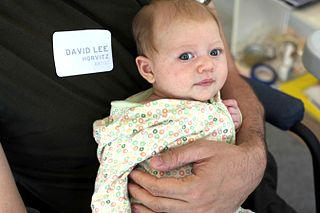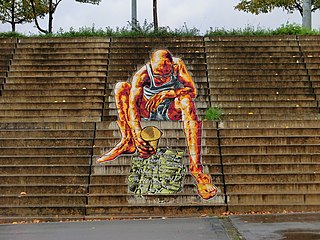Related Research Articles
A tactile illusion is an illusion that affects the sense of touch. Some tactile illusions require active touch, whereas others can be evoked passively. In recent years, a growing interest among perceptual researchers has led to the discovery of new tactile illusions and to the celebration of tactile illusions in the popular science press. Some tactile illusions are analogous to visual and auditory illusions, suggesting that these sensory systems may process information in similar ways; other tactile illusions don't have obvious visual or auditory analogs.

The Necker cube is an optical illusion that was first published as a rhomboid in 1832 by Swiss crystallographer Louis Albert Necker. It is a simple wire-frame, two dimensional drawing of a cube with no visual cues as to its orientation, so it can be interpreted to have either the lower-left or the upper-right square as its front side.

Motion perception is the process of inferring the speed and direction of elements in a scene based on visual, vestibular and proprioceptive inputs. Although this process appears straightforward to most observers, it has proven to be a difficult problem from a computational perspective, and difficult to explain in terms of neural processing.
Multisensory integration, also known as multimodal integration, is the study of how information from the different sensory modalities may be integrated by the nervous system. A coherent representation of objects combining modalities enables animals to have meaningful perceptual experiences. Indeed, multisensory integration is central to adaptive behavior because it allows animals to perceive a world of coherent perceptual entities. Multisensory integration also deals with how different sensory modalities interact with one another and alter each other's processing.
Stereopsis is the component of depth perception retrieved by means of binocular disparity through binocular vision. It is not the only contributor to depth perception, but it is a major one. Binocular vision occurs because each eye receives a different image due to their slightly different positions in one's head. These positional differences are referred to as "horizontal disparities" or, more generally, "binocular disparities". Disparities are processed in the visual cortex of the brain to yield depth perception. While binocular disparities are naturally present when viewing a real three-dimensional scene with two eyes, they can also be simulated by artificially presenting two different images separately to each eye using a method called stereoscopy. The perception of depth in such cases is also referred to as "stereoscopic depth".

Infant vision concerns the development of visual ability in human infants from birth through the first years of life. The aspects of human vision which develop following birth include visual acuity, tracking, color perception, depth perception, and object recognition.
In perceptual psychology, a sensory cue is a statistic or signal that can be extracted from the sensory input by a perceiver, that indicates the state of some property of the world that the perceiver is interested in perceiving.

The flash lag illusion or flash-lag effect is a visual illusion wherein a flash and a moving object that appear in the same location are perceived to be displaced from one another. Several explanations for this simple illusion have been explored in the neuroscience literature.
Bayesian approaches to brain function investigate the capacity of the nervous system to operate in situations of uncertainty in a fashion that is close to the optimal prescribed by Bayesian statistics. This term is used in behavioural sciences and neuroscience and studies associated with this term often strive to explain the brain's cognitive abilities based on statistical principles. It is frequently assumed that the nervous system maintains internal probabilistic models that are updated by neural processing of sensory information using methods approximating those of Bayesian probability.
Visual perception is the ability to interpret the surrounding environment through photopic vision, color vision, scotopic vision, and mesopic vision, using light in the visible spectrum reflected by objects in the environment. This is different from visual acuity, which refers to how clearly a person sees. A person can have problems with visual perceptual processing even if they have 20/20 vision.

Unique hue is a term used in perceptual psychology of color vision and generally applied to the purest hues of blue, green, yellow and red. The proponents of the opponent process theory believe that these hues cannot be described as a mixture of other hues, and are therefore pure, whereas all other hues are composite. The neural correlate of the unique hues are approximated by the extremes of the opponent channels in opponent process theory. In this context, unique hues are sometimes described as "psychological primaries" as they can be considered analogous to the primary colors of trichromatic color theory.
Laurence T. Maloney is an American psychology professor at New York University’s Department of Psychology and Center for Neural Science. He is known for applying mathematical models to human behavior.
Binocular neurons are neurons in the visual system that assist in the creation of stereopsis from binocular disparity. They have been found in the primary visual cortex where the initial stage of binocular convergence begins. Binocular neurons receive inputs from both the right and left eyes and integrate the signals together to create a perception of depth.
Stereoscopic motion, as introduced by Béla Julesz in his book Foundations of Cyclopean Perception of 1971, is a translational motion of figure boundaries defined by changes in binocular disparity over time in a real-life 3D scene, a 3D film or other stereoscopic scene. This translational motion gives rise to a mental representation of three dimensional motion created in the brain on the basis of the binocular motion stimuli. Whereas the motion stimuli as presented to the eyes have a different direction for each eye, the stereoscopic motion is perceived as yet another direction on the basis of the views of both eyes taken together. Stereoscopic motion, as it is perceived by the brain, is also referred to as cyclopean motion, and the processing of visual input that takes place in the visual system relating to stereoscopic motion is called stereoscopic motion processing.
In visual perception, structure from motion (SFM) refers to how humans recover depth structure from object's motion. The human visual field has an important function: capturing the three-dimensional structures of an object using different kinds of visual cues.
Visual crowding is the inability to view a target stimulus distinctly when presented in a clutter. Crowding impairs the ability to discriminate object features and contours among flankers, which in turn impairs people's ability to respond appropriately to the target stimulus.
Ensemble coding, also known as ensemble perception or summary representation, is a theory in cognitive neuroscience about the internal representation of groups of objects in the human mind. Ensemble coding proposes that such information is recorded via summary statistics, particularly the average or variance. Experimental evidence tends to support the theory for low-level visual information, such as shapes and sizes, as well as some high-level features such as face gender. Nonetheless, it remains unclear the extent to which ensemble coding applies to high-level or non-visual stimuli, and the theory remains the subject of active research.
Julie Marie Harris has been Director of Research in the School of Psychology and Neuroscience (2011–21) and a Professor of Vision Science at the University of St Andrews. Her research investigates visual systems and camouflage.

An accidental viewpoint is a singular position from which an image can be perceived, creating either an ambiguous image or an illusion. The image perceived at this angle is viewpoint-specific, meaning it cannot be perceived at any other position, known as generic or non-accidental viewpoints. These view-specific angles are involved in object recognition. In its uses in art and other visual illusions, the accidental viewpoint creates the perception of depth often on a two-dimensional surface with the assistance of monocular cues.

Roland William Fleming, FRSB is a British and German interdisciplinary researcher specializing in the visual perception of objects and materials. He is the Kurt Koffka Professor of Experimental Psychology at Justus Liebig University of Giessen. and the Executive Director of the Center for Mind, Brain and Behavior of the Universities of Marburg and Giessen. He is also co-Spokesperson for the Research Cluster “The Adaptive Mind”.
References
- ↑ Hillis, J. M.; Ernst, M. O.; Banks, M. S.; Landy, M. S. (2002-11-22). "Combining Sensory Information: Mandatory Fusion Within, but Not Between, Senses". Science. 298 (5598): 1627–1630. CiteSeerX 10.1.1.278.6134 . doi:10.1126/science.1075396. ISSN 0036-8075. PMID 12446912. S2CID 15607270.
- ↑ Hillis, James M.; Watt, Simon J.; Landy, Michael S.; Banks, Martin S. (2004-12-01). "Slant from texture and disparity cues: Optimal cue combination". Journal of Vision. 4 (12): 967–92. doi: 10.1167/4.12.1 . ISSN 1534-7362. PMID 15669906.
- ↑ Young, Mark J.; Landy, Michael S.; Maloney, Laurence T. (1993-12-01). "A perturbation analysis of depth perception from combinations of texture and motion cues". Vision Research. 33 (18): 2685–2696. CiteSeerX 10.1.1.63.1844 . doi:10.1016/0042-6989(93)90228-O. PMID 8296465. S2CID 14082052.
- ↑ Oruç, İpek; Maloney, Laurence T.; Landy, Michael S. (2003-10-01). "Weighted linear cue combination with possibly correlated error". Vision Research. 43 (23): 2451–2468. doi: 10.1016/S0042-6989(03)00435-8 . PMID 12972395.
- ↑ "Bergen & Landy. Computational Modeling of Visual Texture Segregation. From M. Landy and J. A. Movshon (eds), Computational Models of Visual Processing (pp. 253-271). Cambridge, MA: MIT Press (1991)". canvas.brown.edu. Retrieved 2017-07-14.
- ↑ Chalupa, Leo M.; Werner, John Simon (2004). The Visual Neurosciences. MIT Press. ISBN 9780262033084.
- ↑ Landy, Michael S.; Bergen, James R. (1991). "Texture segregation and orientation gradient". Vision Research. 31 (4): 679–691. CiteSeerX 10.1.1.78.408 . doi:10.1016/0042-6989(91)90009-T. PMID 1843770. S2CID 1852089.
- ↑ Girshick, Ahna R.; Landy, Michael S.; Simoncelli, Eero P. (2011). "Cardinal rules: visual orientation perception reflects knowledge of environmental statistics". Nature Neuroscience. 14 (7): 926–932. doi:10.1038/nn.2831. PMC 3125404 . PMID 21642976.
- ↑ Larsson, Jonas; Landy, Michael S.; Heeger, David J. (2006). "Orientation-selective adaptation to first-and second-order patterns in human visual cortex". Journal of Neurophysiology. 95 (2): 862–881. doi:10.1152/jn.00668.2005. PMC 1538978 . PMID 16221748.
- ↑ Mamassian, Pascal; Landy, Michael; Maloney, Laurence T. (2002). Bayesian modelling of visual perception. pp. 13–36. doi:10.7551/mitpress/5583.003.0005. ISBN 9780262264327.
{{cite book}}:|journal=ignored (help) - ↑ SciFri (2012-10-12), Step Into an Optical Illusion , retrieved 2017-07-14